Page 237 of 311
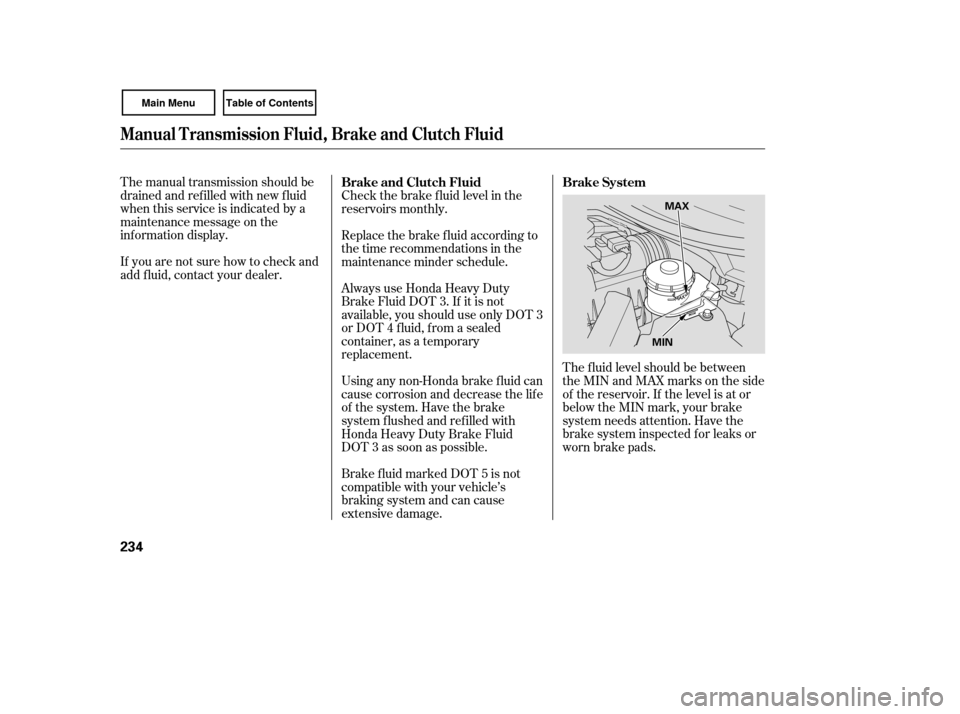
The f luid level should be between
theMINandMAXmarksontheside
of the reservoir. If the level is at or
below the MIN mark, your brake
system needs attention. Have the
brake system inspected f or leaks or
worn brake pads.
The manual transmission should be
drained and ref illed with new f luid
when this service is indicated by a
maintenance message on the
inf ormation display.
If you are not sure how to check and
add f luid, contact your dealer.
Brake f luid marked DOT 5 is not
compatible with your vehicle’s
braking system and can cause
extensive damage. Using any non-Honda brake f luid can
cause corrosion and decrease the lif e
of the system. Have the brake
system f lushed and ref illed with
Honda Heavy Duty Brake Fluid
DOT 3 as soon as possible. Always use Honda Heavy Duty
Brake Fluid DOT 3. If it is not
available, you should use only DOT 3
or DOT 4 f luid, f rom a sealed
container, as a temporary
replacement. Replace the brake f luid according to
thetimerecommendationsinthe
maintenance minder schedule. Check the brake f luid level in the
reservoirs monthly.Brake System
Brake and Clutch Fluid
Manual Transmission Fluid, Brake and Clutch Fluid
234
MAX
MIN
Page 238 of 311
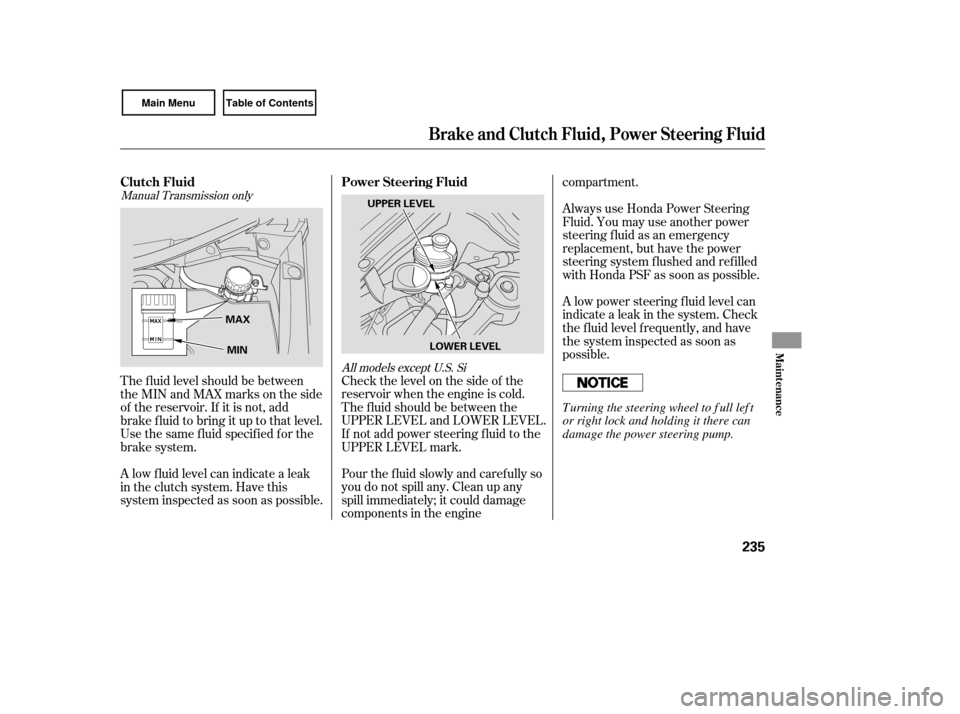
Check the level on the side of the
reservoir when the engine is cold.
The f luid should be between the
UPPER LEVEL and LOWER LEVEL.
If not add power steering f luid to the
UPPER LEVEL mark.
Pour the f luid slowly and caref ully so
you do not spill any. Clean up any
spill immediately; it could damage
components in the enginecompartment.
Always use Honda Power Steering
Fluid. You may use another power
steering f luid as an emergency
replacement, but have the power
steering system f lushed and ref illed
with Honda PSF as soon as possible.
A low power steering f luid level can
indicate a leak in the system. Check
the f luid level f requently, and have
the system inspected as soon as
possible.
The f luid level should be between
theMINandMAXmarksontheside
of the reservoir. If it is not, add
brake f luid to bring it up to that level.
Use the same fluid specified for the
brake system.
A low f luid level can indicate a leak
in the clutch system. Have this
system inspected as soon as possible.
Manual Transmission only
All models except U.S. Si
Brake and Clutch Fluid, Power Steering Fluid
Power Steering Fluid
Clutch Fluid
Maint enance
235
MAX
MIN LOWER LEVEL
UPPER LEVEL
Turning the steering wheel to f ull lef t
or right lock and holding it there can
damage the power steering pump.
Page 257 of 311
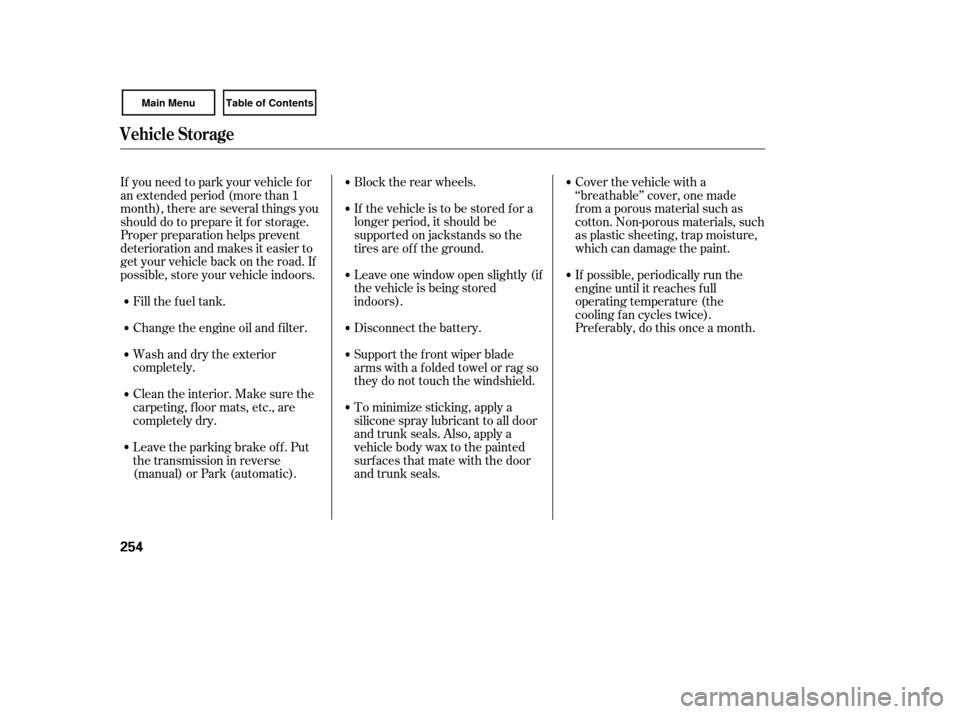
Fill the f uel tank.
Change the engine oil and f ilter.Block the rear wheels.
If the vehicle is to be stored f or a
longer period, it should be
supported on jackstands so the
tires are of f the ground.
Wash and dry the exterior
completely.
Cleantheinterior.Makesurethe
carpeting, floor mats, etc., are
completely dry.
If you need to park your vehicle f or
an extended period (more than 1
month), there are several things you
should do to prepare it f or storage.
Proper preparation helps prevent
deterioration and makes it easier to
get your vehicle back on the road. If
possible, store your vehicle indoors. Leave one window open slightly (if
the vehicle is being stored
indoors).Cover the vehicle with a
‘‘breathable’’ cover, one made
f rom a porous material such as
cotton. Non-porous materials, such
as plastic sheeting, trap moisture,
which can damage the paint.
To minimize sticking, apply a
silicone spray lubricant to all door
and trunk seals. Also, apply a
vehiclebodywaxtothepainted
surfaces that mate with the door
and trunk seals. Support the f ront wiper blade
arms with a f olded towel or rag so
they do not touch the windshield. Disconnect the battery. If possible, periodically run the
engine until it reaches f ull
operating temperature (the
cooling f an cycles twice).
Pref erably, do this once a month.
Leave the parking brake off. Put
the transmission in reverse
(manual) or Park (automatic).
Vehicle Storage
254
Page 260 of 311
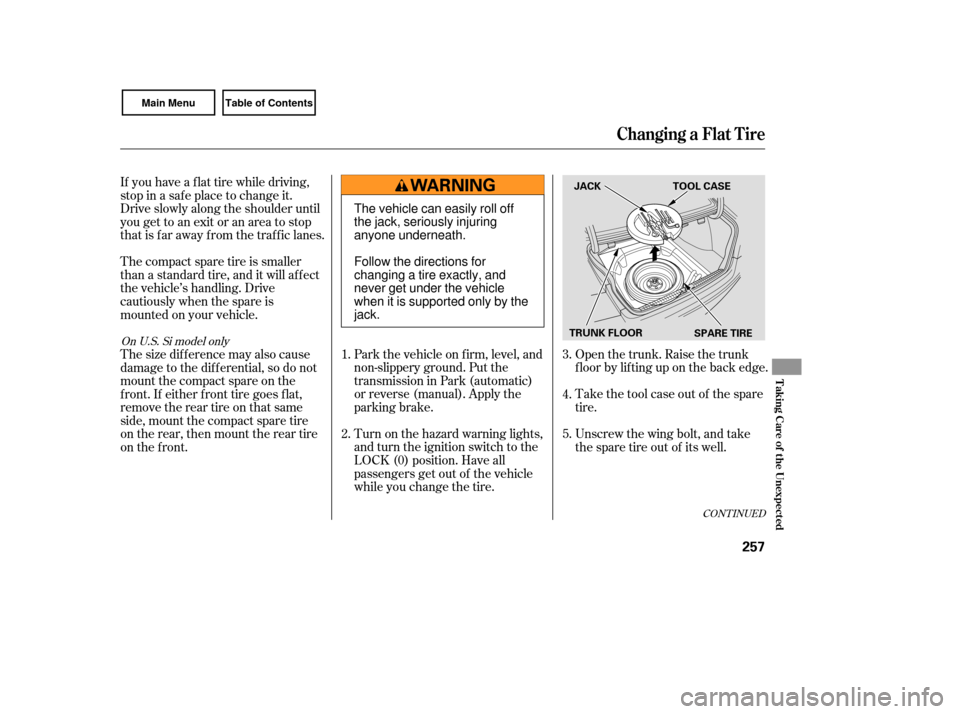
Turn on the hazard warning lights,
and turn the ignition switch to the
LOCK (0) position. Have all
passengers get out of the vehicle
while you change the tire. Park the vehicle on f irm, level, and
non-slippery ground. Put the
transmission in Park (automatic)
or reverse (manual). Apply the
parking brake.Open the trunk. Raise the trunk
f loor by lif ting up on the back edge.
Take the tool case out of the spare
tire.
Unscrew the wing bolt, and take
the spare tire out of its well.
If you have a f lat tire while driving,
stop in a saf e place to change it.
Drive slowly along the shoulder until
you get to an exit or an area to stop
that is far away from the traffic lanes.
Thecompactsparetireissmaller
than a standard tire, and it will affect
the vehicle’s handling. Drive
cautiously when the spare is
mounted on your vehicle.
Thesizedifferencemayalsocause
damage to the dif f erential, so do not
mount the compact spare on the
f ront. If either f ront tire goes f lat,
removethereartireonthatsame
side, mount the compact spare tire
on the rear, then mount the rear tire
on the f ront.
5. 4.
3.
2. 1.
CONT INUED
On U.S. Si model only
Changing a Flat Tire
T aking Care of t he Unexpect ed
257
SPARE TIRE
TRUNK FLOOR JACK TOOL CASE
The vehicle can easily roll off
the jack, seriously injuring
anyone underneath.
Follow the directions for
changing a tire exactly, and
never get under the vehicle
when it is supported only by the
jack.
Page 264 of 311
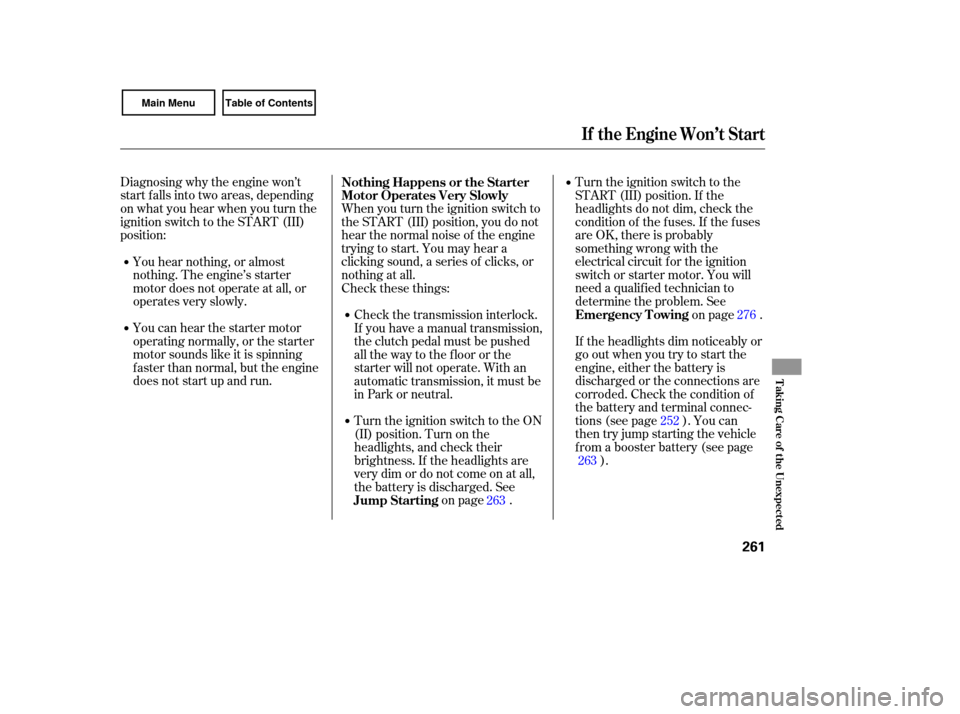
Diagnosing why the engine won’t
start falls into two areas, depending
on what you hear when you turn the
ignition switch to the START (III)
position: Wh
en you turn the ignition switch to
the START (III) position, you do not
hear the normal noise of the engine
trying to start. You may hear a
clicking sound, a series of clicks, or
nothing at all. Turn
the ignition switch to the
START (III) position. If the
headlights do not dim, check the
condition of the fuses. If the fuses
areOK,thereisprobably
something wrong with the
electrical circuit for the ignition
switch or starter motor. You will
need a qualified technician to
determine the problem. See
on page .
If the headlights dim noticeably or
go out when you try to start the
engine, either the battery is
discharged or the connections are
corroded. Check the condition of
the battery and terminal connec-
tions (see page ). You can
then try jump starting the vehicle
from a booster battery (see page
).
You
can hear the starter motor
operating normally, or the starter
motor sounds like it is spinning
faster than normal, but the engine
does not start up and run.
You
hear nothing, or almost
nothing. The engine’s starter
motor does not operate at all, or
operates very slowly.
Turn the ignition switch to the ON
(II) position. Turn on the
headlights, and check their
brightness. If the headlights are
very dim or do not come on at all,
the battery is discharged. See
on page .
Check the transmission interlock.
If you have a manual transmission,
the clutch pedal must be pushed
all the way to the f loor or the
starter will not operate. With an
automatic transmission, it must be
in Park or neutral.
Check these things:
263 276
252
263
Nothing Happens or the Starter
Motor Operates Very Slowly
Emergency T owing
Jump Starting
If theEngineWon’tStart
T aking Care of t he Unexpect ed
261
Page 279 of 311
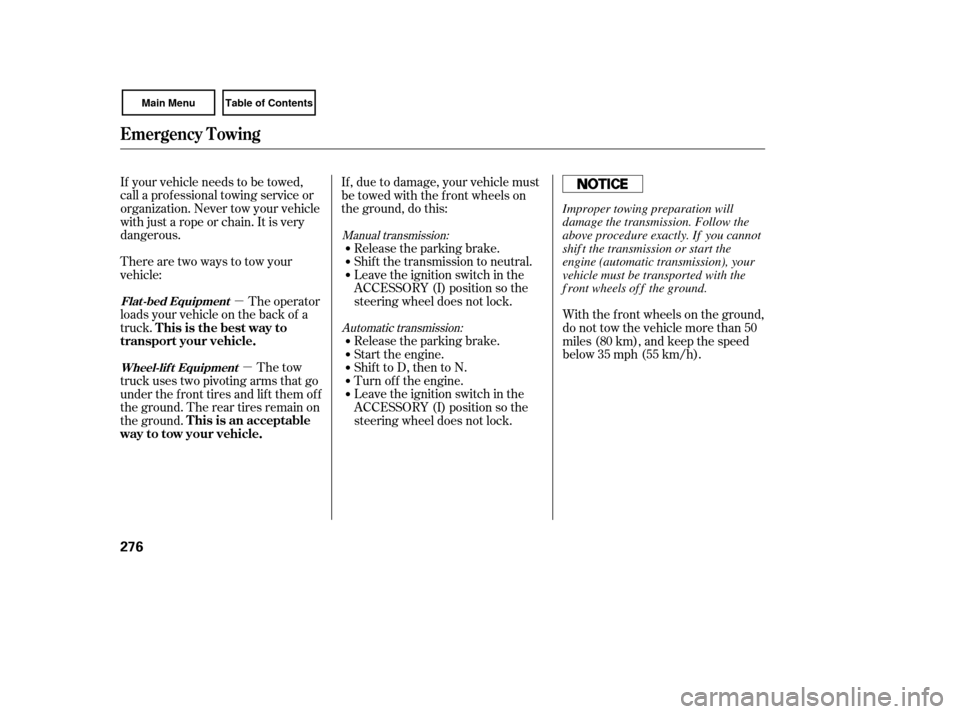
�µ�µ
If your vehicle needs to be towed,
call a prof essional towing service or
organization. Never tow your vehicle
with just a rope or chain. It is very
dangerous.
The operator
loads your vehicle on the back of a
truck. Therearetwowaystotowyour
vehicle: If , due to damage, your vehicle must
be towed with the f ront wheels on
the ground, do this:
Release the parking brake.
Shif t the transmission to neutral.
Turn of f the engine. ShifttoD,thentoN.
Start the engine.
Release the parking brake. Leave the ignition switch in the
ACCESSORY (I) position so the
steering wheel does not lock.
Leave the ignition switch in the
ACCESSORY (I) position so the
steering wheel does not lock.
The tow
truck uses two pivoting arms that go
under the f ront tires and lif t them of f
the ground. The rear tires remain on
the ground. With the f ront wheels on the ground,
do not tow the vehicle more than 50
miles (80 km), and keep the speed
below35mph(55km/h).
Manual transmission:
Automatic transmission:
Flat -bed Equipment
Wheel-lif t Equipment
T his is the best way to
transport your vehicle.
This is an acceptable
way to tow your vehicle.
Emergency Towing
276
Improper towing preparation will
damage the transmission. Follow the
above procedure exactly. If you cannot
shif t the transmission or start the
engine (automatic transmission), your
vehicle must be transported with the
f ront wheels of f the ground.
Page 284 of 311
The engine number is stamped into
the engine block. It is on the f ront.
The transmission number is on a
label on top of the transmission.
Identif ication Numbers
Technical Inf ormation
281
MANUAL TRANSMISSION
NUMBER ENGINE NUMBER ENGINE NUMBER
AUTOMATIC/MANUAL
TRANSMISSION NUMBER
Except U.S. Si
U.S. Si
Page 285 of 311

�Î�Î
�Î
�Î �Î
�Î �Î
�Î
�Î
�Î
�Î
�Î
�Î
�Î
�Î
�Î
�Î
�Î �Î
�Î
�Î
�Î
�Î
�Î
�Î
�Î
�Î
�Î
�Î
�Î �Î
�Î
�Î
�Î
Specif ications
282
Dimensions
Weights
EngineCapacities
176.7 in (4,489 mm)
69.0 in (1,752 mm)
56.5 in (1,435 mm)
106.3 in (2,700 mm)
59.0 in (1,499 mm)
60.2 in (1,528 mm)
3.19 x 3.44 in (81.0 x 87.3 mm)
Length
Width
Height
Wheelbase
Track
Gross vehicle weight rating See the certification label attached
to the driver’s doorjamb.
Water cooled 4-stroke
SOHC VTEC , DOHC i-VTEC 4-cylinder gasoline engine
10.5
110 cu-in (1,799 cm
)
3.39x3.39in(86x86mm)
122 cu-in (1,998 cm)
SK22PR-M11S IFR7G-11KS
SKJ20DR-M11S
IZFR6K-11S
NGK:
DENSO:
Type
BorexStroke
Displacement
Compression ratio
Spark plugs
Spark plugs 13.2 US gal (50
)
Excluding the oil remaining in the engine Including the coolant in the reserve tank and that remaining in
the engine
Reserve tank capacity: 0.11 US gal (0.4
)
4.8 US qt (4.5
)
2.6 US qt (2.5)
2.5 US qt (2.4
)
6.2 US qt (5.9)
1.8 US qt (1.7
)
1.7 US qt (1.6)
1.6 US qt (1.5)
1.5 US qt (1.4)
5.8 US qt (5.5)
4.8 US qt (4.5)
4.4 US qt (4.2)
3.7 US qt (3.5)
4.6 US qt (4.4)
3.9 US qt (3.7)
1.19 US gal (4.5
)
1.37 US gal (5.2)
1.45 US gal (5.5)
1.88 US gal (7.1
)
1.72 US gal (6.5)
1.80 US gal (6.8)
11.0 Fuel tank
Engine
coolant
Engine oil
Automatic
transmission
fluid
Windshield
washer
reservoir
Front
Rear
Approx.
NGK:
DENSO:
1:
2: 1:
2:
3:
4:A/T
M/T
A/T
M/T
Change
Total
Change
Including
filter
Without filter
Total
Change
Total
Change
Total
U.S. Vehicles
Canada
Vehicles
Except U.S. Si
U.S. Si Except U.S. Si
U.S. Si
12
1
2 3
4 3
4
3
4
3
4
3
4
1
2
1
2 1
2
3
3
4
3
3
4
1
2
Manual trans-
mission fluid